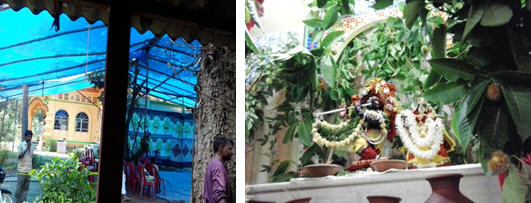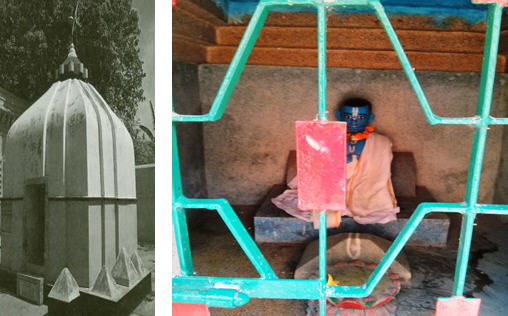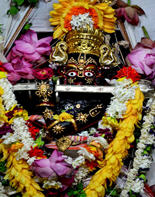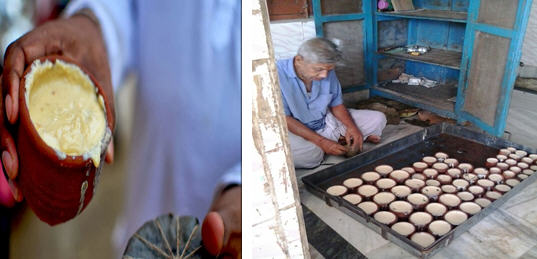The Name “Ksira-cora” means “one who stole condensed milk”. When Lord Caitanya visited the Gopinatha temple in Remuna, He told the devotees traveling with Him that how the Deity had received that name. Lord Caitanya had heard the story from His spiritual master, Isvara Puri, a disciple of Madhavendra Puri. As related in Caitanya-caritamrta, it is Madhavendra Puri for whom the condensed milk was stolen.
. 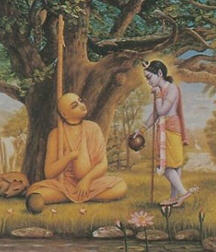
Madhavendra Puri was a highly advanced devotee of Lord Krsna. While living in Vrndavana absorbed in remembering the pastimes of the Lord, he saw Krsna appear in a dream and told him that He had been buried for a long time in a jungle nearby. Krsna wanted Madhavendra Puri to dig Him up. Following the Lord’s instruction, with the help of the local people Madhavendra Puri discovered a Deity of Krsna named Gopala.
Madhavendra Puri built a temple for Gopala and served Him for two years. Then again one night Gopala appeared to him in a dream and asked him to go to Orissa to get sandalwood to smear on His body.
On the way to Orissa, Madhavendra Puri stopped at the Gopinatha temple in Remuna. He asked the priest what kind of food was offered to Gopinatha, thinking he could offer the same preparations to his own Deity, Gopala. The priest mentioned the condensed milk (ksira) known as amrta-keli, which was famous because its taste was nectarean.
That evening, while the priest made an offering to the Lord, Madhavendra Puri thought that if the priest were to offer him some of the condensed milk he could taste it and then be able to prepare it for Gopala. He then at once became ashamed for thinking of tasting the Lord’s food during the offering. Feeling he had committed a great offense, he left the temple and went to a vacant marketplace to chant the names of the Lord.
Later that night, the Gopinatha Deity appeared in a dream to the priest and told him He had hidden a pot of condensed milk behind His cloth. Gopinatha told the priest to deliver the condensed milk to a saintly person named Madhavendra Puri. The priest did as told.
Madhavendra Puri felt ecstasy to learn that the Lord had stolen condensed milk for him. After drinking the milk, Madhavendra Puri kept the pot, and every day he would eat a little piece of it.
Birth place of Sridhar Swami
The literary history of 14th century Sanskrit scholar and saint Sridhar Swami lies in obscurity here at Mayurgram village in Remuna block, around 20km from the district headquarters. He is known to be the earliest writer to hail from Balasore. At present, nothing is found at his birthplace, except a statue.
. 
Sridhar Swami was an acclaimed Sanskrit litterateur and had combined the Advaita teachings of Shankar with the devotion of the Bhagavad Gita. It is believed that he laid the first foundation of the Vaisnava Bhakti movement in Bengal on the basis of Gita during Shankara reign.
His commentary on Srimad Bhagavad influenced other writers of his era, especially the Odia poet, Jagannath Das. It is believed that Das followed Swami’s commentary while composing Bhagavad Gita.
Swami’s childhood is little known, yet according to a researcher, Umakanta Panda, he left his body at Kapilash in Dhenkanal.
“Hardly any literature is found on Swami. The original manuscripts are not found and whatever literature written on him got washed away in floods,” said Ramakanta Majhi, a parishad member in Mayurgram village.
Srila Prabhupada accepted him as a Vaishnava and Srila Bhaktisiddhanta considered him to be from the Vishnu-swami sampradaya. Additionally, Jiva Goswami states in his Tattva-sandarbha that he cites only those portions of the revered Sridhara Swami’s commentary that follow the natural spirit of the Bhagavatam and its Vaisnava conclusions. This is because Sridhara Swami interspersed his Bhagavatam commentaries with monistic advaita interpretations-not as conclusions, but as a tactic to attract the followers of Sankara from their dry cakes of impersonal philosophy to the Bhagavatam’s nectarean descriptions of Krsna-lila. Sri Chaitanya Mahaprabhu Himself greatly appreciated Sridhara Swami’s Bhagavatam commentaries and became very much disturbed when Vallabha bhatta did not show proper respect to Sridhara Swami. This is probably the reason why some sources claim Sridhar Swami belongs to the Sankara Sampradaya even though he was actually a Vaisnava.
Birth Place of Baldev Vidyabhushan
The Remuna area is also the birthplace of Sridhara Svami, the original commentator on Srimad-Bhagavatam. Baladeva Vidyabhusana, a great spiritual master in the line of Lord Caitanya. You can visit their birthplaces if you can find someone to guide you; most of the local people don’t seem to know about these places. Baldev Vidyabhushan was born in the village Athantar (Remuna). Devotees connected with Shyamananda prabhu sampraday of gaudiya vaishnavas hold every year a wonderful celebration on his disappearance festival.
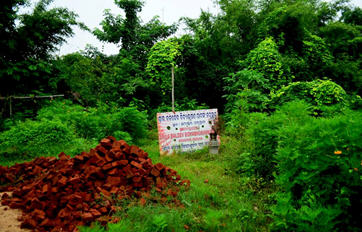
ISKCON – Remuna. Recently Iskcon has acquired a beautiful land in Remuna close to Kshirchor Gopinath temple. H.G Mukund chaitanya p (08908006925) can be contacted for making arrangements for stay, Prasad and tour.
